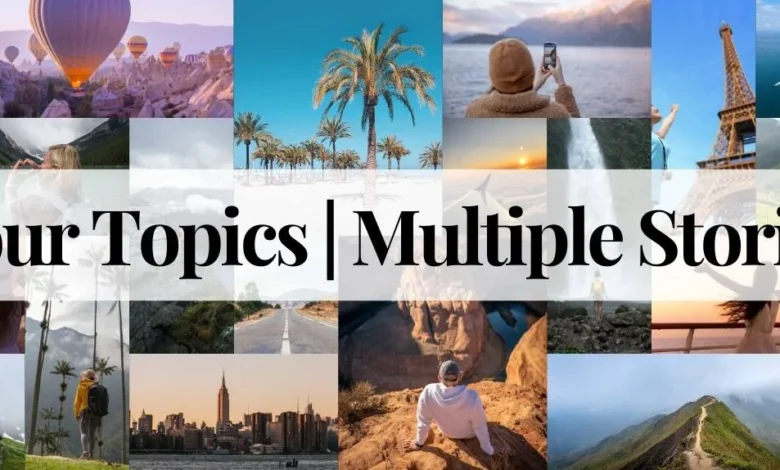Your Topics | Multiple Stories: Exploring the Power of Diverse Narratives

In today’s digital world, information moves at lightning speed. From social media platforms to online magazines, we consume a variety of stories every single day. But what makes this era truly unique is the ability to access your topics of interest and explore multiple stories surrounding them. Whether you’re fascinated by technology, culture, sports, or personal development, the internet offers endless narratives that help broaden perspectives, inspire action, and connect communities.
This article dives into how “your topics” can shape your learning journey, why reading multiple stories enhances understanding, and how diverse perspectives empower individuals and societies alike.
The Rise of Personalized Content
The concept of your topics has gained significant traction with the rise of digital platforms. Algorithms now track browsing behavior, likes, shares, and time spent on content to curate a feed tailored to individual preferences. For example:
A sports enthusiast might see multiple stories about football matches, player transfers, or upcoming tournaments.
A tech-savvy reader might find stories about artificial intelligence, gadgets, and software updates.
A lifestyle-focused audience could be exposed to stories on health, wellness, travel, and relationships.
This personalization ensures that readers are not overwhelmed with irrelevant data but can instead focus on your topics—the subjects that matter most to them.
Multiple Stories, Multiple Perspectives
One of the most powerful aspects of consuming multiple stories is the exposure to diverse perspectives. For instance, a single global event—like a major election, environmental crisis, or sporting championship—can generate hundreds of narratives across news outlets, blogs, and social media platforms.
Why does this matter? Because every story is influenced by culture, geography, and even personal biases. By engaging with multiple stories, readers gain a more holistic understanding rather than a one-sided view.
Take climate change as an example:
One story might highlight the science behind rising temperatures.
Another might focus on the economic impact on farming communities.
Yet another could share personal narratives of families displaced by floods or wildfires.
When these multiple stories are combined, they paint a fuller picture, allowing readers to appreciate both the global scale and the human element of the issue.
Your Topics as a Learning Tool
Choosing your topics is more than just entertainment—it’s an educational tool. Imagine a student interested in entrepreneurship. By following multiple stories on startups, innovation, and business leaders, they can:
Learn practical business strategies.
Understand global market trends.
Discover failures and success stories that provide inspiration.
Similarly, a person passionate about health and fitness can find guidance through multiple stories covering diet plans, workout routines, and personal transformations. This approach not only strengthens knowledge but also motivates individuals to take action in their own lives.
The Power of Storytelling
Storytelling has been part of human culture since ancient times. What has changed is the accessibility of those stories. In the digital space, storytelling is no longer limited to books or TV—everyone can share their experiences through blogs, podcasts, vlogs, or even a short social media post.
This democratization of content creation means your topics can be explored not just through traditional journalism but also through personal stories from everyday individuals. Reading multiple stories from diverse creators allows us to step into different worlds, empathize with others, and see issues from angles we may never have considered.
Balancing Depth and Breadth
While following your topics across multiple stories can be enriching, it’s essential to strike a balan
Multiple Stories in Everyday Life
The idea of multiple stories doesn’t just apply to media—it’s relevant in everyday life. Every individual carries their own narrative, shaped by experiences, challenges, and triumphs. In workplaces, communities, and families, acknowledging multiple stories creates empathy and strengthens ce between depth and breadth. Consuming too many stories at once can lead to “information overload,” leaving readers confused or overwhelmed.
Here are some strategies for balance:
Prioritize quality over quantity: Choose credible sources that provide well-researched content.
Diversify perspectives: Don’t rely on just one platform; check multiple outlets for a broader view.
Deep-dive occasionally: Instead of skimming headlines, take time to explore in-depth stories for a stronger understanding.
By applying this balance, your topics become not just a source of scattered knowledge but a structured learning experience.
relationships.
For example:Technology’s Role in Expanding Narratives
Technology has made it easier than ever to explore your topics and access multiple stories. Platforms like Google News, Reddit, Medium, and even TikTok enable users to find stories on everything from politics to pop culture. Artificial intelligence further enhances this experience by recommending content that matches interests while introducing related topics that broaden horizons.
In a team setting, listening to multiple stories of how colleagues approach a challenge fosters collaboration.
In education, hearing multiple stories of historical events makes learning richer and more engaging.
In personal growth, reflecting on your own stories alongside those of others creates resilience and motivation.
However, technology also poses challenges. Echo chambers—where algorithms only show what aligns with existing beliefs—can limit exposure to diverse perspectives. To counter this, it’s important to intentionally seek multiple stories, even those that challenge your views.
The Impact on Society
When individuals engage with your topics and explore multiple stories, society benefits as a whole. Informed citizens are better equipped to make decisions, whether in voting, supporting businesses, or addressing community issues. Storytelling becomes a tool for social change, advocacy, and innovation.
Movements like #MeToo or climate activism gained momentum not just from a single narrative but from multiple stories shared across platforms, resonating with people worldwide. These stories united communities, inspired action, and influenced policy discussions.
Conclusion: Your Topics | Multiple Stories as a Lifestyle
In a world overflowing with information, focusing on your topics allows you to stay engaged with what truly matters to you. Meanwhile, exploring multiple stories ensures that your understanding is enriched with diverse perspectives, experiences, and insights.
By embracing this approach, you’re not just consuming content—you’re building knowledge, fostering empathy, and connecting with global communities. Whether for personal growth, professional development, or societal awareness, the combination of your topics and multiple stories is a powerful way to navigate the modern digital landscape.



